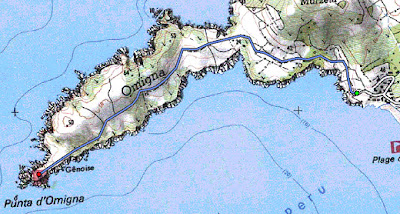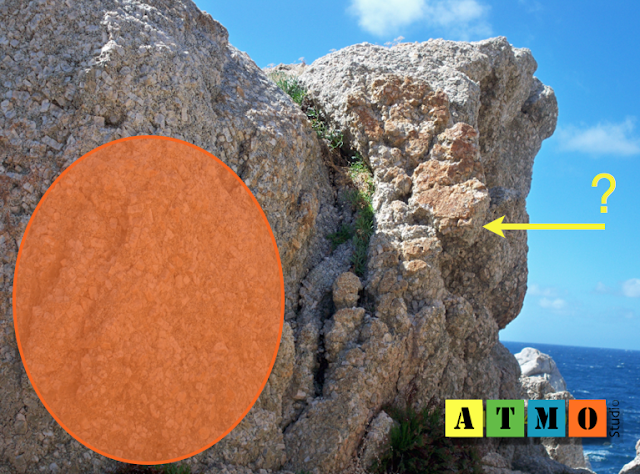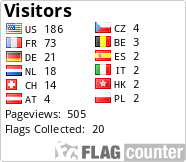VERSION FRANCAISE
Punta di Omigna
La pointe d’Omigna est une avancée étroite dans la mer sur la côte ouest de la Corse. Elle forme avec la pointe d’Orchinu et la pointe de Cargèse le trio fermant le golfe de Sagone au nord.

Après la randonnée pour arriver à proximité de la tour, vous sortez du maquis pour entrer sur une étendue granitique pratiquement sans végétation. C'est dans cette étendue que vous trouverez plusieurs formations géologiques intéressantes qui sont le sujet de cette Earthcache.
Le granite
Le granite est une roche plutonique magmatique à texture grenue, c'est-à-dire entièrement cristallisée et composée de minéraux bien développés et visibles à l'œil nu. Celle-ci est le résultat du refroidissement lent, en profondeur, de grandes masses de magma qui formeront des plutons, ces derniers étant actuellement en surface grâce au jeu de l'érosion qui a décapé les roches sus-jacentes. Ces magmas, acides (c'est-à-dire relativement riches en silice) sont essentiellement le résultat de la fusion partielle de la croûte terrestre continentale. Certains granites (plagiogranites) rencontrés en petits plutons dans la croûte océanique sont, quant à eux, le résultat de la différentiation ultime de magmas basiques. Les granites sont formés de minéraux en grains (cristaux), tous visibles à l'œil nu ; cette apparence leur vaut leur nom dérivé du latin granum, grain. Ces minéraux sont principalement du quartz, des micas (biotite et/ou muscovite), des feldspaths potassiques (orthoses) et des plagioclases. Ils peuvent contenir également de la hornblende, de la magnétite, du grenat, du zircon et de l'apatite. En tout, on dénombre aujourd'hui plus de 500 couleurs de granites différentes. Le granite à une densité moyenne de 2,7 tonne/m3.
Les boules de granite
Autour du point N 42° 8.835', E 8° 33.664' de nombreux blocs de granites forment des boules monumentales.

Trouvez le lieu de la photo A ci-dessus et calculez la masse (en tonne) du bloc globalement sphérique photographié.
Faille et structure
Au point N 42° 8.790', E 8° 33.558' vous trouverez une faille dans laquelle vous pouvez passer.

Dans la photo B ci dessus vous voyez le côté ouest de la faille (qui est globalement orientée nord-sud). A partir de la flèche jaune mesurez la largeur de la faille jusqu'à son coté est.
Le granite présent sur la zone est défini comme granite à gros grains. Décrivez la structure visible à l'oeil nu dans la zone marquée par le cercle rouge sur la photo B.
La Earth Cache
Pour valider cette Earth Cache vous devez m'envoyer un e-mail avec les réponses aux questions suivantes.
- Evaluer le poids de la boule de la photo A
- Mesurer la largeur de la faille de la photo B
- Décrire la structure de la photo B
Nous apprécierons si vos logs sont accompagnés de photos prises sur place !
ENGLISH VERSION
Punta di Omigna
Omigna tip is advanced close to the sea on the west coast of Corsica. It forms with the tip of Orchinu and the tip of Cargèse a trio closing the Gulf of Sagone north.

After hiking to get close to the tower, you exit the bush to enter an extended granite almost without vegetation. It is in this range you will find many interesting geological formations that are the subject of this Earthcache.
Le granite
Granite (is a common widely occurring type of intrusive, felsic, igneous rock. Granite usually has a medium- to coarse-grained texture. Occasionally some individual crystals (phenocrysts) are larger than the groundmass, in which case the texture is known as porphyritic. A granitic rock with a porphyritic texture is sometimes known as a porphyry. Granites can be pink to gray in color, depending on their chemistry and mineralogy. By definition, granite is an igneous rock with at least 20% quartz by volume. Granite differs from granodiorite in that at least 35% of the feldspar in granite is alkali feldspar as opposed to plagioclase; it is the alkali feldspar that gives many granites a distinctive pink color. Outcrops of granite tend to form tors and rounded massifs. Granites sometimes occur in circular depressions surrounded by a range of hills, formed by the metamorphic aureole or hornfels. Granite is usually found in the continental plates of the Earth's crust. The average density of granite is between 2.7ton/m3
The balls of granite
Around the point 42 ° N 8835 'E 8 ° 33,664' numerous blocks of granite forming balls monumental.

Find the location of the picture A above and calculate the mass (in tons) of the block spherical overall photographed.
Fault and structure
At point N 42 ° 8790 ', 8 ° E 33558' you will find a fault where you can pass.

In the picture B above you see the west side of the fault (which is generally oriented north-south). From the yellow arrow measure the width of the fault to its east side.
The granite of this area is defined as coarse-grained granite. Describe the structure visible to the naked eye in the area marked by the red circle on the picture B.
The Earth Cache
To validate this Earth Cache you must send me an email with the following questions.
- Evaluate the weight of the ball of the pictureA
- Measure the width of the fault of the picture B
- Describe the structure of the picture B
We will appreciate if your logs are accompanied by photos taken there!
